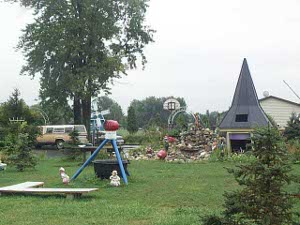 House in Adrian, Michigan
House in Adrian, Michigan
After we left Findlay we drove to Michigan to visit friends, then returned to Ohio. In the course of these two drives we had two vastly different impressions of Toledo.
Going north, we skirted the city, and stopped for a walk in a Toledo MetroPark named Oak Openings. The term "Oak Openings" describes what biologists call an oak savanna, with widely spread oaks surrounded by grasses. Our path led us, just before a summer rainstorm, through a deciduous forest, then into a grove of eighty-foot-tall pines swaying and creaking in the breeze, then across a patch of prairie before taking us back to the lake, covered with algae, where we had begun. This was one of our nicest nature walks.
On our return we drove through downtown Toledo, and were distressed by the urban decay. The city is full of boarded up buildings and streets that haven't been swept in weeks.
 House in Adrian, Michigan
House in Adrian, Michigan
Toledo, according to our guidebook, is the third largest Great Lakes port; the Maumee River enters Lake Erie. There are refineries, glass factories, lots of shipping, downtown skyscrapers -- and, as we saw, urban blight.
A smaller town, Adrian, Michigan, has made great efforts to restore its late-19th century buildings; we drove through their historic district and enjoyed the architectural decorations.
Ann Arbor and Ypsilanti by contrast are busy and attractive cities, partly due, no doubt, to the presence of two impressive universities. We visited a chemist and a ceramicist with their labs full of specialized equipment for teaching and research. We saw the new library at Eastern Michigan University, where most of the book collection is housed in bins, to be retrieved and delivered to the reader by a series of automated devices. While impressed by the technology and the architecture, we wish today's EMU students could have the heady experience of wandering the stacks.
A large white tent on our hotel parking lot housed the new Volkswagens which were rolled out during our stay, apparently viewed by dealers from near and far.
We found ourselves in Fremont, Ohio, home of the Rutherford B. Hayes Museum and Library, a private enterprise which predates the modern National Archives repositories of presidential papers.
Hayes became president with 48.8% of the popular vote, and a 1-vote electoral majority. This was put together by the Republican party after the election, by promising to end reconstruction in five southern states, who thereby named electors pledged to Hayes.
A Cincinnati lawyer and principled Ohioan, Hayes had volunteered for the Union Army. He ended up serving under Sheridan as a brevet Major General. After the war he served in Congress, and then as Ohio Governor, where he put into practice many of the ideas of nineteenth-century prison reform.
As president he carried through with the Republican promises to end Reconstruction, but was dismayed by the rise of Jim Crow. His wife, Lucy, was the first female student at Ohio Wesleyan and took an active role as first lady.
Hayes was a proponent of reservations: he believed that only by restricting them to controllable areas could the Indians be taught the white  A personal vision
man's culture. Perhaps the most remarkable feature of the special exhibit on nineteenth century government treatment of Native Americans was the document issued last year by the Under Secretary for Indian Affairs; it is a forthright apology, on behalf of the U. S. government for the multitude of its past sins. The Secretary hoped that the BIA and Native Americans can work to redress those wrongs. We feel that whether the BIA should continue as a federal agency is debatable.
A personal vision
man's culture. Perhaps the most remarkable feature of the special exhibit on nineteenth century government treatment of Native Americans was the document issued last year by the Under Secretary for Indian Affairs; it is a forthright apology, on behalf of the U. S. government for the multitude of its past sins. The Secretary hoped that the BIA and Native Americans can work to redress those wrongs. We feel that whether the BIA should continue as a federal agency is debatable.
One of the great delights of back road travel is the occasional surprise. Just outside a small Ohio town were two personal artistic visions, situated across the road from each other. One sculptor had filled his acre with statues cut from sheet steel by his welding torch; his neighbor had appropriated railroad signals and built grottoes and gardens with painted figures. Clearly their juxtaposition was fueling their artistic rivalry!